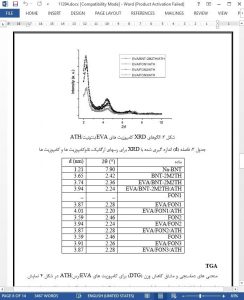Abstract
A new modification process for the preparation of organoclay has been devised. Functional organoclay nanofillers (FONs) based on the mixing of bentonite and other inorganic fillers such as fumed silica, aluminium trihydroxide (ATH) and sepiolite were prepared and employed to obtain composites of ethylene–vinyl acetate and ATH. These composites were characterised by means of X-ray diffraction, thermogravimetric analysis, mechanical and fire retardant properties. The results confirmed that the modification process for the preparation of FONs is able to influence the intercalated structure of the clay, and hence the mechanical properties and behaviour as flame retardant materials.
Introduction
Ethylene–vinyl acetate (EVA) copolymers are extensively used in the cable industry as excellent insulating materials with good mechanical properties. To reduce the large amount of smoke produced during combustion, metal hydroxides, such as aluminium trihydroxide (ATH), are added to the polymer. However, the inclusion of these additives causes the mechanical properties of these materials to decrease significantly. Thus, the combination of bentonite nanoclay with other inorganic fillers during the modification of the nanoclays used as reinforcement of polymer matrices was presented as a new way to improve the thermal stability of polymers, while maintaining the mechanical properties [1].
Conclusions
Composites of EVA/clay/ATH with different organoclay functionalizations were created and characterised. The new modification process using bentonite and other inorganic fillers led to an increase of the interlayer space of nanoclays within the composite, an improvement in stiffness with a reduction in toughness, and also, an enhancement in flame retardant properties. Overall, the silica-based functional organoclay (FON1) showed to be the best nanofiller option to improve the mechanical and fire retardant properties of EVA/clay/ATH composites.











